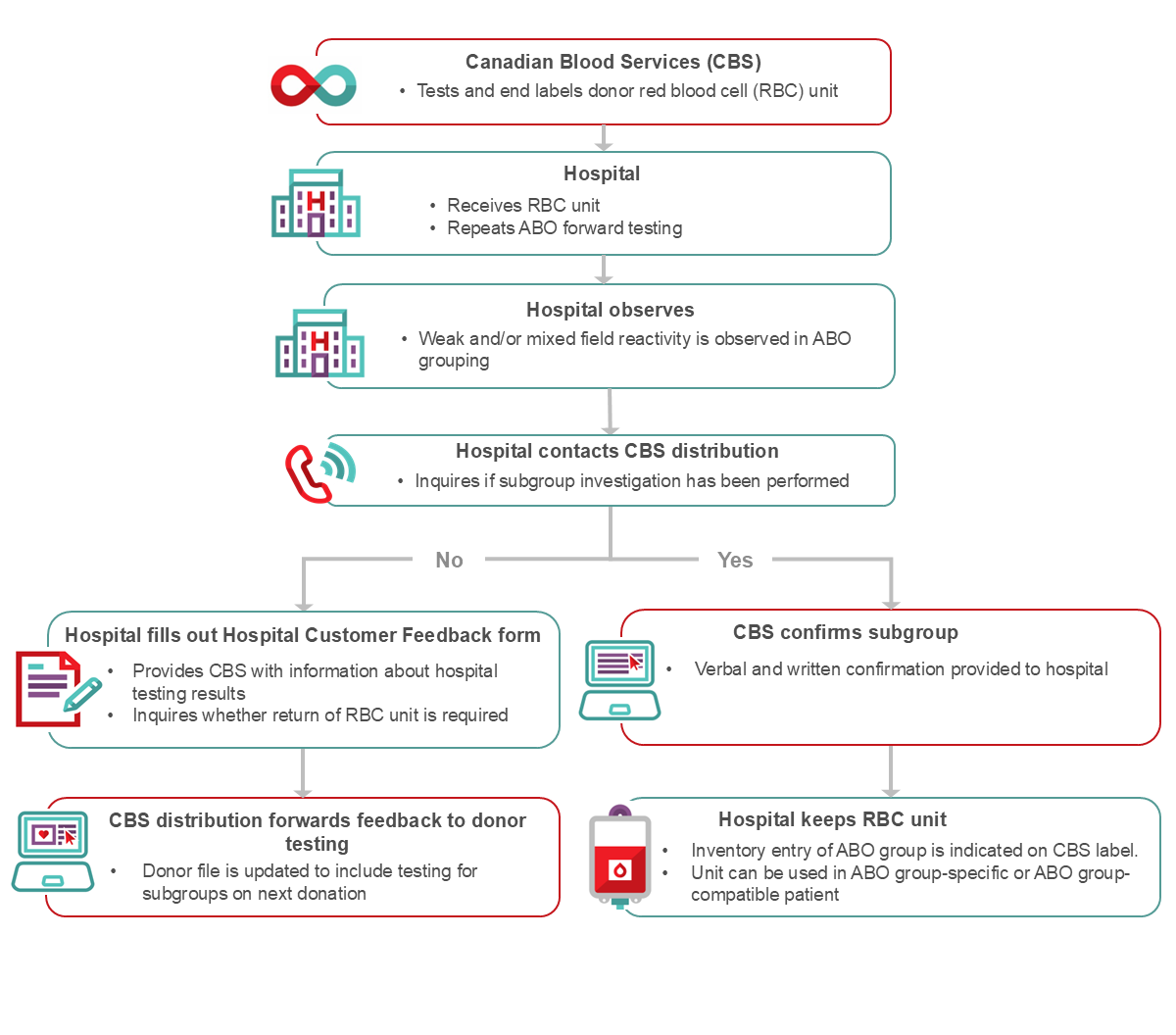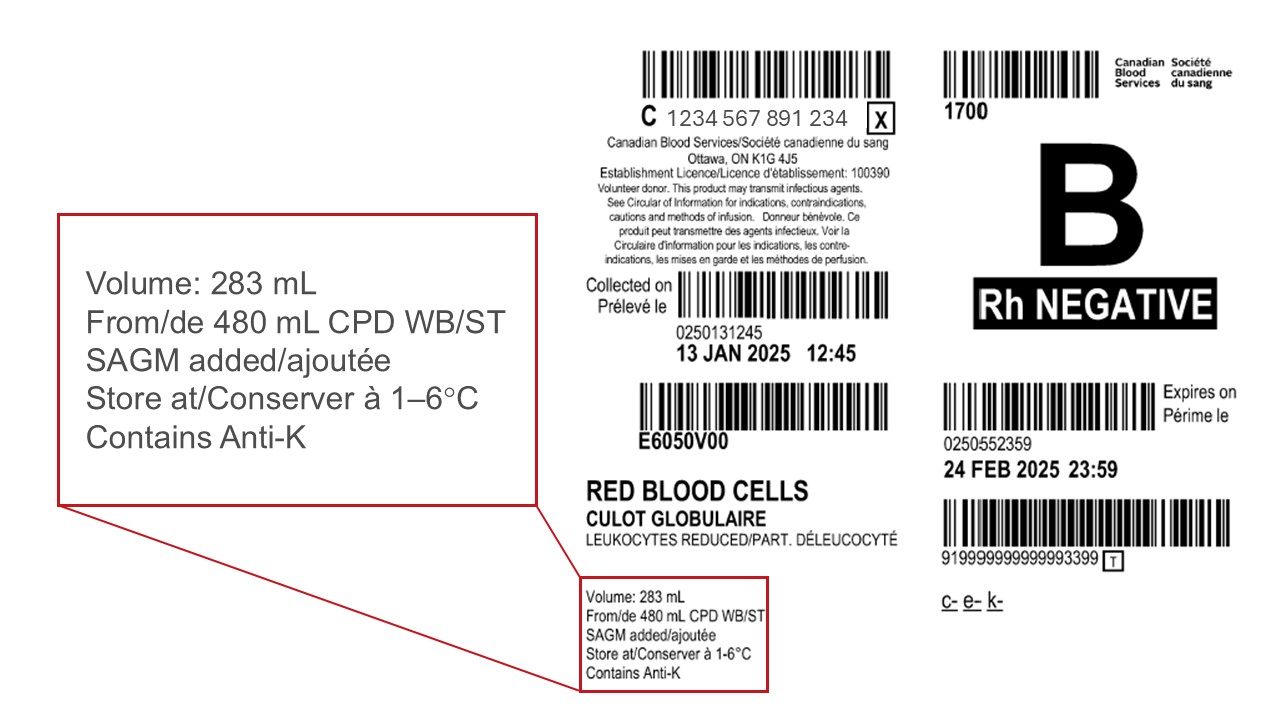This blood group system was discovered by Landsteiner and Levin in 1927 and named after the first three antigens identified in the system: M, N and S. There are currently 50 antigens which have been described in this system.2 The genes GYPA and GYPB encode for the glycophorin A and glycophorin B products which act as a chaperone for band 3 transport to the red blood cell membrane. The M and N antigens are located on glycophorin A and the S and s antigens are located on glycophorin B.3, 4
Anti-M
Key points
- Anti-M is sometimes clinically significant.1 Patients with anti-M detectable at 37°C (IAT phase) may be provided red blood cell units that are crossmatch compatible by IAT at 37°C.
- People with anti-M who have sickle cell disease should be provided with M-negative red blood cell units for transfusion.5, 6
- If a pregnant person has an IgG anti-M that reacts at 37°C, ongoing titration is required, and the paternal partner should be tested for the M antigen.7
Background
The M antigen is part of the MNS blood group system and is located on the red blood cell surface glycoprotein known as glycophorin A.2 The M antigen is present in 74% to 78% of most populations.
The antibody, anti-M may be naturally occurring (i.e., arising without stimulus by transfusion-related or pregnancy-related red blood cell exposure) or can be an immune-stimulated antibody. In either case, it is predominantly an IgM antibody with some associated IgG component and often occurs in association with other antibodies.3 Frequently anti-M antibodies have a low thermal amplitude with predominant reactivity at lower temperatures. If a “new” anti-M is found in a prenatal person, it is not unusual to find at delivery that the baby is M-negative. This is presumptive evidence that the anti-M seen prenatally in the maternal plasma is naturally occurring and not immune stimulated.
In the context of transfusion, anti-M is considered clinically insignificant for most patients.8 It does not typically contribute to acute or delayed hemolytic transfusion reactions. An exception is anti-M in some people with sickle cell disease. In this context, anti-M can contribute to hemolysis or even trigger hyperhemolysis.5
Anti-M is rarely associated with hemolytic disease of the fetus and newborn (HDFN).1, 9
Management: Pre-transfusion and prenatal testing
Pre-transfusion
When anti-M is detected in pre-transfusion sample testing, it is usually not clinically significant. There is no requirement for selection of M-negative donor red blood cells. Instead, red blood cell units that are crossmatch compatible by IAT at 37°C may be selected for transfusion.1 Some international transfusion recommendations do suggest that M-negative donor red blood cell units should be selected if the antibody is IAT reactive, but this is not uniform practice in Canada.
Anti-M may react in gel IAT methods more strongly than by tube methods and lead to an incompatible gel crossmatch. If this happens, saline tube IAT may be used to find compatible units., In addition, an IAT pre-warm technique can sometimes be helpful.10 Often, anti-M reacts best at room temperature or 4 °C, even if there is an IgG component to the antibody. Pre-warm techniques may therefore diminish or eliminate anti-M reactivity and allow for a compatible crossmatch.
The M antigen is not usually considered when seeking phenotypically matched red blood cells. For people undergoing therapies which induce hypothermia, including some cardiac surgical procedures, providing M-negative units for patients with anti-M is recommended by some transfusion services. There is no evidence to support this requirement and some evidence to suggest that this practice is not required.11 See the summary table for an overview of recommendations for red blood cell transfusion in patients with non-ABO antibodies.
Prenatal
Anti-M is a common antibody detected in prenatal samples. Most often it is not clinically significant as it is predominantly an IgM antibody which does not cross the placental barrier.
To distinguish IgM from IgG anti-M, some antibody identification methods exist that exclude IgM antibodies (Figure 1). In addition, special techniques such as dithiothreitol (DTT) treatment of plasma may help distinguish between the two. When the anti-M is an IgG antibody that reacts at 37°C and has a high or rising titre, it may be a clinically significant antibody that can cross the placenta and affect the fetus. In these cases, the paternal partner should be tested for the M antigen. The birthing parent’s anti-M levels are monitored with regular antibody titration during the antenatal period. An approach to monitoring anti-M antibodies has been suggested that involves intermittent titration to detect rising titres with regular follow-up titration only in those rare cases that demonstrate increasing antibody levels.12, 13
Only very rarely does anti-M reach a critical titre necessitating a referral to maternal-fetal medicine for further fetal monitoring. Anti-M may act through fetal erythroid suppression rather than through hemolysis, which may result in neonatal onset anemia in addition to or instead of fetal anemia. Occasional case reports of severe intrauterine fetal anemia due to anti-M can be found.7, 9 This is very exceptional, however, and despite the relatively common detection of anti-M in pregnant people, significant fetal or neonatal anemia is very unusual in North America.
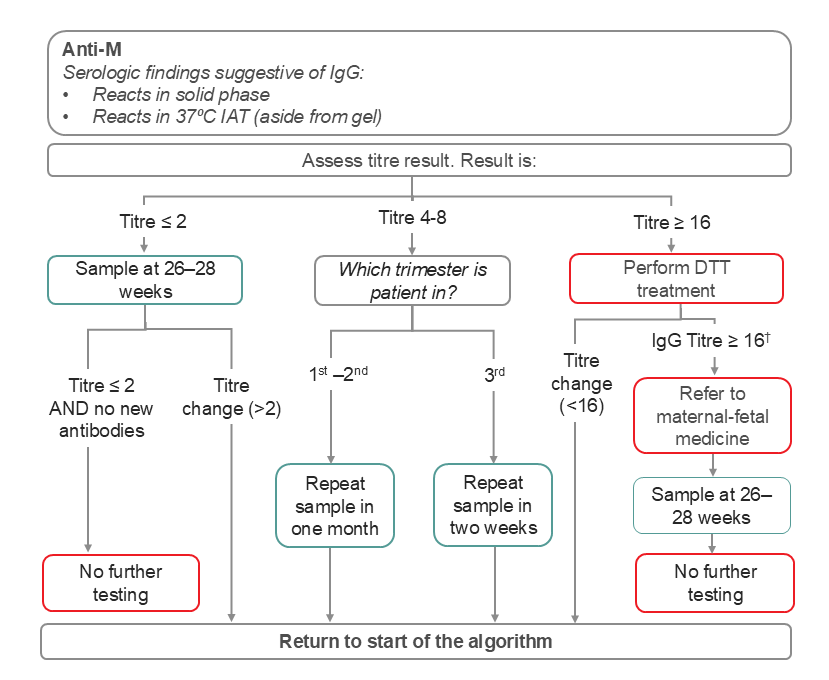
Figure 1. Suggested Prenatal Testing Algorithm for Anti-M.
Please note that this is an adapted algorithm and that its use should reflect your laboratory conditions and patient population. The algorithm should not be applied for patients with a prior history of HDFN due to anti-M. In this setting, early referral to maternal fetal medicine is indicated. Unless otherwise indicated, titre was performed on neat plasma.
†DTT-treated plasma = IgG titre
People with sickle cell disease
For people with sickle cell disease with an identified anti-M, M-negative red blood cell units should be provided, in addition to phenotyping that otherwise matches the patient red blood cell antigen and antibody profile.5, 14 Anti-M in this clinical context can be associated with hemolytic reactions; therefore, assuring compatibility by providing M antigen-negative red blood cells is recommended.
Glycophorin hybrids (anti-Mi(a), anti-Mur, anti-Bun, anti-Vw, anti-HUT)
Key points
- Mi(a) refers to a group of low prevalence antigens formed as a result of hybrid rearrangements of the genes encoding for the MN and Ss antigens (glycophorin A and B respectively). Examples include GP.Mur, GP.Hut, GP.Vw among others).
- Mi(a) antigens may be expressed in up to 6-15% of individuals of Asian ancestry but are relatively rare in individuals of European descent (0.1-0.2%).
- anti-Mi(a) and related antibodies can cause mild to fatal hemolytic disease of the fetus and newborn (HDFN).
- As with other antibodies to low prevalence antigens (LPA), anti-Mia is typically not identified on a prenatal antibody screen because the screening cells are Mi(a)-negative). Antibodies to LPA are often found when the neonate is jaundiced and/or found to have a positive DAT with a negative maternal antibody screen.
- Anti-Mi(a) antibodies have rarely been associated with hemolytic transfusion reactions.
Background
Glycophorin hybrids are a group of antigens found on glycophorin A (GPA) and glycophorin B (GPB), and result from complex gene fusions and rearrangement events. Unlike single nucleotide polymorphisms, which produce many of the common blood group antigen variants, these rearrangements can cause the expression of strings of amino acids with multiple novel antigens, which can then stimulate multiple discreet antibodies (Figure 2).
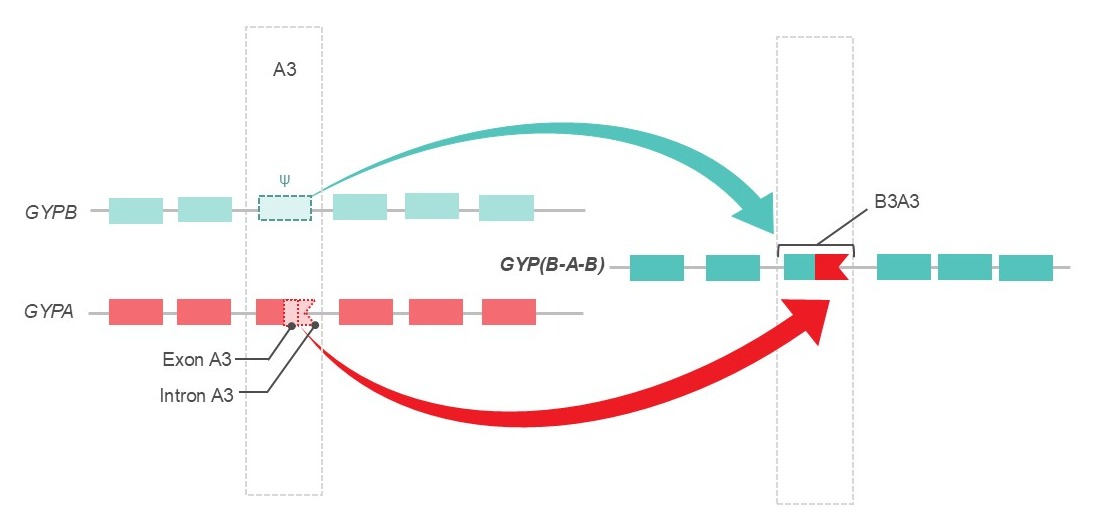
Figure 2. Example of a gene recombination event found in glycophorin hybrids GP.Mur, GP.Bun, GP.Hop and GP.HF. In these hybrids, a portion of glycophorin A (GYPA) replaces the end of pseudoexon B3 (Ψ) from glycophorin B (GYPB). This attaches a functional splice site to B3, which causes it to be expressed when it is normally not, leading to the expression of multiple novel antigens: Mi(a), Mur, Hil, MUT, and MINY 2,3. Figure adapted from Daniels & Sanger, 2013.3
Mi(a) derives its name from the Miltenberger series, an obsolete naming convention. The Reid and Tippett naming convention has replaced it,15, 16 as it incorporates sequencing and biochemical data to better characterize these phenotypes (table 1). It is important to note that the name “Mi(a)” is typically used to represent a group of antigens which includes Mur and Vw (among others). However, it has also been discovered that Mi(a) is a discreet antigen with a commercially available monoclonal antibody,2 adding further confusion in the nomenclature. Therefore, if a patient has formed a new anti-Mi(a), that antibody may be reacting to a single antigen (usually Mur or Vw) or may be multiple antibodies that react with any of the phenotypes containing Mi(a) (table 1).
Table 1. Serological definition of the Miltenberger phenotypes and a replacement notation, adapted from Daniels and Sanger, 2013 (p. 118). 2–4
| Phenotypes | Antigens | |||||||||||
|---|---|---|---|---|---|---|---|---|---|---|---|---|
| Mi class | New notation (Reid and Tippett) | Mi(a) | Vw | Mur | Hil | Hut | MUT | Hop | Nob | DANE | TSEN | MINY |
| Mi.I | GP.Vw | + | + | - | - | - | - | - | - | - | - | - |
| Mi.II | GP.Hut | + | - | - | - | + | + | - | - | - | - | - |
| Mi.III | GP.Mur | + | - | + | + | - | + | - | - | - | - | + |
| Mi.IV | GP.Hop | + | - | + | - | - | + | + | - | - | + | + |
| Mi.V | GP.Hil | - | - | - | + | - | - | - | - | - | - | + |
| Mi.VI | GP.Bun | + | - | + | + | - | + | + | - | - | - | + |
| Mi.VII | GP.Nob | - | - | - | - | - | - | - | + | - | - | - |
| Mi.VIII | GP.Joh | - | - | - | - | - | - | + | + | - | NT | - |
| Mi.IX | GP.Dane | - | - | + | - | - | - | - | - | + | - | - |
| Mi.X | GP.HF | + | - | - | + | - | + | - | - | - | - | + |
| Mi.XI | GP.JL | - | - | - | - | - | NT | - | - | - | + | + |
License number: 6110920764012
NT: Not tested
GP.Mur is the most common phenotype.17 The incidence of this hybrid glycophorin in white people is low and reported as 0.0098%; however the incidence is much higher in people of Chinese and Southeast Asian ancestry (6%–15%).2, 3 There is substantial variation within this large ethnic group, with subpopulations reported to reach incidences of up to 88%.18 GP.Bun is not always reported as a separate entity to GP.Mur. In one study of people of Thai ancestry, 9.03% were Mi(a)-positive (by serology), and of those 88.3% were GP.Mur and 11.7% were GP.Bun-positive by gene sequencing, with no other hybrid glycophorins detected.19 Other glycophorin hybrids have been reported in populations of European ancestry at frequencies close to 0.05%, with GP.Vw reported to be as high as 1.4% in people of Swiss ancestry.17 Comprehensive case reviews have been written by Heathcote et al.17 and Mallari et al.20, which include more detailed summaries of the epidemiology of these phenotypes. Of case reports of severe HTR or HDFN, 94% arise from exposure to GP.Mur and GP.Vw.17
Management: Pre-transfusion and prenatal testing
PRE-TRANSFUSION
Detection of anti-Mi(a) in non-pregnant patients does not usually pose a significant challenge for blood provision in Western countries as most donors are Mi(a) negative.
Antibodies to glycophorin hybrids can be naturally occurring or immune stimulated. Naturally occurring antibodies are usually IgM, and not clinically significant.17 This phenomenon is well-known for anti-Vw, occurring in 0.5% of people with no pregnancy or transfusion history,2 and is the reason why Vw-positive red blood cells are intentionally not included on screening panels.17 Heathcote et al.17 provide a comprehensive review of the literature with regards to HTRs. There has been one fatal case of HTR described, where the patient reacted to a single GP.Vw red cell unit.21 All HTR cases had IgG present with titres ranging from 8 to 512. There have been no reported cases of HTR with IgM only. The most commonly implicated antibodies amongst this group are anti-Mi(a), anti-Mur, anti-MUT and to a lesser degree anti-Hil.
If an antibody to LPA is suspected in non-pregnant patients, specimens can be referred to a reference laboratory for serologic testing of LPAs, and genetic testing can be considered if confirmation is required.22, 23 Although anti-Mi(a) can cause severe HTR,17 these patients are unlikely to encounter the Mi(a) antigen in countries like Canada where the prevalence is low in the donor pool. As with other positively identified antibodies, patients can be safely transfused with IAT crossmatch-compatible units. Antibody class testing through dithiothreitol treatment of plasma may be considered to determine the presence of IgG and/or IgM, as IgM-only antibodies are not clinically significant.17, 23 Sourcing Mi(a)-negative units is not required, and donor Mi(a) antigen testing is not routinely performed at Canadian Blood Services. Antisera is not widely available and testing requests may cause unnecessary delays in transfusion.
PRENATAL
Although rarely reported, anti-Mi(a) does pose a risk for mild to fatal HDFN.2, 3, 17, 20, 24 There is clear evidence that high-titre IgG antibodies to hybrid glycophorins are a significant risk for HDFN, while the more common and naturally occurring IgM-only antibodies are very unlikely to cause severe reactions. It is uncertain if low-titre IgG antibodies can cause severe reactions, as there are case reports where titres were not performed. Most cases have been reported in Asia,17 especially in Taiwan and Hong Kong, and the most commonly identified antibody was anti GP.Mur. In HDFN cases where IgG titres have been reported, titres ranged from 32 to 1024, and severe HDFN has been reported in first pregnancies.17 In groups of European ancestry, GP.Vw is the most likely glycophorin hybrid to stimulate anti-Mi(a). The reported IgG titres range from 32 to 128.17Detection of glycophorin hybrid antibodies (anti-Mi(a), anti-Mur and anti-Vw) in pregnancy is a growing challenge as ethnic diversity increases with immigration worldwide.20, 24 Anti-Mi(a) has been compared to anti-Kell in its frequency and potential severity in people of Asian ancestry;20 however, it is not included in routine screening panels designed for Western ethnic groups. For this reason some providers advocate for the inclusion of Mi(a) positive screening cells for antenatal testing, especially for those of Asian ancestry; however, to date, commercially available screening cells are not typically Mi(a)-positive.20, 24
Antibodies to LPAs (including anti-Mi(a)) should be considered as a possible cause of HDFN in cases where there is unexplained neonatal jaundice with a positive direct antiglobulin test (DAT) and with a negative maternal and/or neonatal antibody screen. Especially if there have been previous undiagnosed pregnancy losses (see Figure 3), further investigation of antibody status in the birth parent and partner and neonatal antigen typing, usually through red cell antigen genotyping is imperative.20
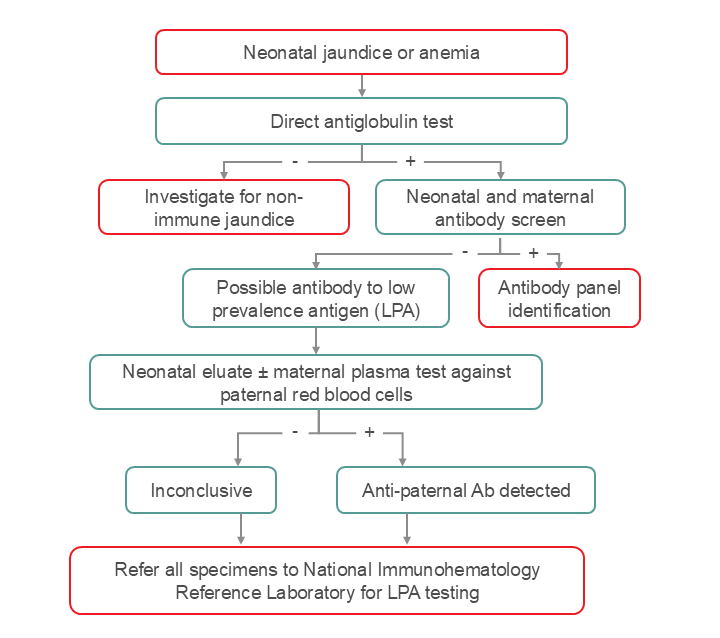
Figure 3. Recommended testing strategy for the investigation of an antibody to a low prevalence antigen (LPA) such as anti-Mi(a). In the setting of unexplained neonatal jaundice or anemia with a positive DAT, if the antibody investigation is negative (either for the mother or newborn), this should trigger the clinical and laboratory teams to consider an antibody to an LPA. An intermediate step could be to do an eluate of newborn cells to retrieve the anti-Mia and test the resulting plasma against paternal cells. Alternatively, maternal plasma can be used to test against paternal cells if anti-A or anti-B do not interfere (i.e., if maternal and paternal samples are group identical, or if maternal cells are group AB). National Immunohematology Reference Laboratory (NIRL) may provide testing or advice.
Maternal-fetal medicine counselling is strongly recommended if antibodies to glycophorin hybrids are known or identified in the prenatal period. There are no current guidelines on critical maternal titres, however, the review by Heathcote et al. suggests titres of 32 or more increase risk for clinically significant HDFN.17
For cases where anti Mia is suspected, genetic blood group antigen testing should be considered for the infant and father to identify glycophorin hybrids, as they may impact future pregnancies and transfusion requirements.20, 24 For subsequent pregnancies or if the paternal partner is known to be antigen-positive, early referral to maternal-fetal medicine for fetal anemia monitoring and consideration of titration against Mi(a)-positive cells at 2–4-week intervals is recommended.20 Testing for Mi(a) antigen can be arranged through the National Immunohematology Reference Laboratory (NIRL) by contacting your local transfusion medicine service.

